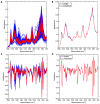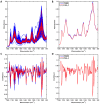Point-of-Care Disease Screening in Primary Care Using Saliva: A Biospectroscopy Approach for Lung Cancer and Prostate Cancer
- PMID: 38003848
- PMCID: PMC10672293
- DOI: 10.3390/jpm13111533
Point-of-Care Disease Screening in Primary Care Using Saliva: A Biospectroscopy Approach for Lung Cancer and Prostate Cancer
Abstract
Saliva is a largely unexplored liquid biopsy that can be readily obtained noninvasively. Not dissimilar to blood plasma or serum, it contains a vast array of bioconstituents that may be associated with the absence or presence of a disease condition. Given its ease of access, the use of saliva is potentially ideal in a point-of-care screening or diagnostic test. Herein, we developed a swab "dip" test in saliva obtained from consenting patients participating in a lung cancer-screening programme being undertaken in north-west England. A total of 998 saliva samples (31 designated as lung-cancer positive and 17 as prostate-cancer positive) were taken in the order in which they entered the clinic (i.e., there was no selection of participants) during the course of this prospective screening programme. Samples (sterile Copan blue rayon swabs dipped in saliva) were analysed using attenuated total reflection Fourier-transform infrared (ATR-FTIR) spectroscopy. In addition to unsupervised classification on resultant infrared (IR) spectra using principal component analysis (PCA), a range of feature selection/extraction algorithms were tested. Following preprocessing, the data were split between training (70% of samples, 22 lung-cancer positive versus 664 other) and test (30% of samples, 9 lung-cancer positive versus 284 other) sets. The training set was used for model construction and the test set was used for validation. The best model was the PCA-quadratic discriminant analysis (QDA) algorithm. This PCA-QDA model was built using 8 PCs (90.4% of explained variance) and resulted in 93% accuracy for training and 91% for testing, with clinical sensitivity at 100% and specificity at 91%. Additionally, for prostate cancer patients amongst the male cohort (n = 585), following preprocessing, the data were split between training (70% of samples, 12 prostate-cancer positive versus 399 other) and test (30% of samples, 5 prostate-cancer positive versus 171 other) sets. A PCA-QDA model, again the best model, was built using 5 PCs (84.2% of explained variance) and resulted in 97% accuracy for training and 93% for testing, with clinical sensitivity at 100% and specificity at 92%. These results point to a powerful new approach towards the capability to screen large cohorts of individuals in primary care settings for underlying malignant disease.
Keywords: ATR-FTIR spectroscopy; cancer screening; chemometrics; saliva; swab; “dip” test.
Conflict of interest statement
The authors declare no conflict of interest. The funders had no role in the design of the study; in the collection, analyses, or interpretation of data; in the writing of the manuscript; or in the decision to publish the results.
Figures




Similar articles
-
ATR-FTIR Spectroscopy with Chemometrics for Analysis of Saliva Samples Obtained in a Lung-Cancer-Screening Programme: Application of Swabs as a Paradigm for High Throughput in a Clinical Setting.J Pers Med. 2023 Jun 25;13(7):1039. doi: 10.3390/jpm13071039. J Pers Med. 2023. PMID: 37511652 Free PMC article.
-
Non-invasive diagnostic test for lung cancer using biospectroscopy and variable selection techniques in saliva samples.Analyst. 2024 Sep 23;149(19):4851-4861. doi: 10.1039/d4an00726c. Analyst. 2024. PMID: 39105622
-
Ultrarapid On-Site Detection of SARS-CoV-2 Infection Using Simple ATR-FTIR Spectroscopy and an Analysis Algorithm: High Sensitivity and Specificity.Anal Chem. 2021 Feb 9;93(5):2950-2958. doi: 10.1021/acs.analchem.0c04608. Epub 2021 Jan 22. Anal Chem. 2021. PMID: 33481583
-
Attenuated total reflection Fourier-transform infrared spectral discrimination in human bodily fluids of oesophageal transformation to adenocarcinoma.Analyst. 2019 Dec 2;144(24):7447-7456. doi: 10.1039/c9an01749f. Analyst. 2019. PMID: 31696873
-
Histology verification demonstrates that biospectroscopy analysis of cervical cytology identifies underlying disease more accurately than conventional screening: removing the confounder of discordance.PLoS One. 2014 Jan 3;9(1):e82416. doi: 10.1371/journal.pone.0082416. eCollection 2014. PLoS One. 2014. PMID: 24404130 Free PMC article.
Cited by
-
Innovative label-free lymphoma diagnosis using infrared spectroscopy and machine learning on tissue sections.Commun Biol. 2024 Oct 31;7(1):1419. doi: 10.1038/s42003-024-07111-7. Commun Biol. 2024. PMID: 39482420 Free PMC article.
-
The Promise of Infrared Spectroscopy in Liquid Biopsies for Solid Cancer Detection.Diagnostics (Basel). 2025 Feb 4;15(3):368. doi: 10.3390/diagnostics15030368. Diagnostics (Basel). 2025. PMID: 39941298 Free PMC article. Review.
References
-
- Pastorino U., Silva M., Sestini S., Sabia F., Boeri M., Cantarutti A., Sverzellati N., Sozzi G., Corrao G., Marchianô A. Prolonged lung cancer screening reduced 10-year mortality in the MILD trial: New confirmation of lung cancer screening efficacy. Ann. Oncol. 2019;30:1162–1169. doi: 10.1093/annonc/mdz117. - DOI - PMC - PubMed
-
- Barauna V.G., Singh M.N., Barbosa L.L., Marcarini W.D., Vassallo P.F., Mill J.G., Ribeiro-Rodrigues R., Campos L.C.G., Warnke P.H., Martin F.L. Ultrarapid on-site detection of SARS-CoV-2 infection using simple ATR-FTIR spectroscopy and an analysis algorithm: High sensitivity and specificity. Anal. Chem. 2021;93:2950–2958. doi: 10.1021/acs.analchem.0c04608. - DOI - PubMed
-
- Martin F.L., Dickinson A.W., Saba T., Bongers T., Singh M.N., Bury D. ATR-FTIR spectroscopy with chemometrics for analysis of saliva samples obtained in a lung-canceer-screening programme: Application of swabs as a paradigm for high throughput in a clinical setting. J. Pers. Med. 2023;13:1039. doi: 10.3390/jpm13071039. - DOI - PMC - PubMed
Grants and funding
LinkOut - more resources
Full Text Sources
Miscellaneous

